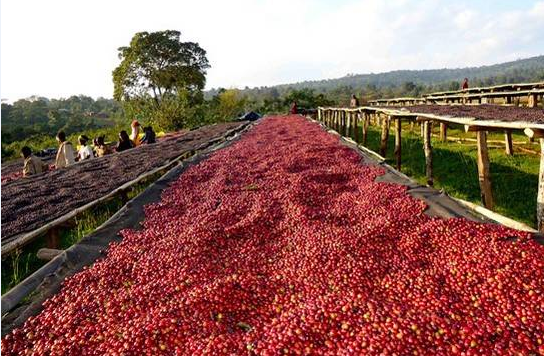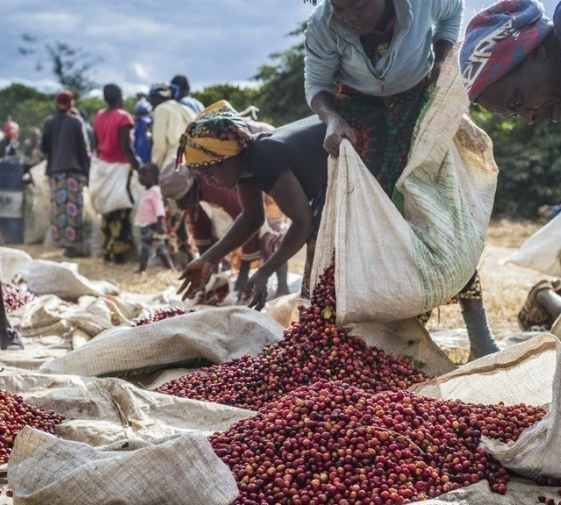The history of coffee, what is coffee cherry (Coffee Cherry)? What red cherry project?
The History of Red Cherry
Monks and sheep
Coffee beans were first found and eaten by locals on the African continent.
From 575 BC to 850 BC, coffee spread from Ethiopia to the Arab region, and there are many speculations about the spread process, one is that the indigenous Africans brought coffee beans to Arabia during the migration, and the other is that the religious giants, the Sufi, who are famous for their plunder, brought coffee beans back during the invasion.
There is a third saying that shepherds living near the monastery find their sheep awake all night and look like monks for help. After investigation, the monk found that the sheep were eating a kind of shrub berries every day. He picked some and took them to the monastery to boil them and drink them. As a result, the fatigue was swept away and there were no side effects. He immediately shared it with other monks in order to keep the experience of prayer adequate.
Coffee trees have been planted and eaten in monasteries ever since.
From eating to drinking
In the earliest days in Ethiopia, coffee berries were crushed and mixed with animal fat to make small balls as supplies for warriors on the battlefield. In the context of "tribal conflict" at that time, this method of eating was very popular because the pulp of coffee beans was sweet and contained caffeine.
Later, people began to ferment coffee pulp to make wine, called "Kawa", which also has a refreshing effect.
People used coffee shells to make coffee in 1000 BC, but they dried the beans when they tried to make coffee in the 13th century. My guess is that, in order to facilitate preservation, let the harvested coffee fruit be stored longer, so I choose to dry it. Unexpectedly, the process of brewing coffee has taken another step forward.
In the later period, coffee developed in Yemen, slowly forming a leisure place such as a coffee shop, and coffee was gradually transformed from a drink enjoyed by religious aristocrats into a civilian drink.
The history of coffee
Only one thing is reasonable: coffee trees are native to Ethiopia, originating from the Abyssinian region of Kaffa and growing in a wonderful coffee forest 9 to 2000 meters above sea level. The ancestors of the Galla, a nomadic people living in the bustling Sidamo province of southern Ethiopia, have long known the refreshing effects of coffee beans. They mash coffee beans and mix them with animal fat to make some kind of energy supplement.
The Legend of Cody the Shepherd; Ancient Parchment, Addis Ababa, Ethiopia.
In the early 16th century, coffee began to spread from the monastery in Yemen to major cities (first to Cairo), attracting enthusiasts from all walks of life. The "black drink" was so popular that in about 1523, a provision was even added to Turkey's marriage agreement that husbands must ensure that their wives have the right amount of coffee to drink, and violators must divorce.
Arabs have long struggled to maintain their monopoly in the coffee trade, but millions of believers make a pilgrimage to Mecca every year, making it impossible to monitor them one by one. One of them is Baba? Pilgrims of Baba Budan swallowed seven red fruits in 1670 and planted them on their farmland in the Chandragiri Hills Mountains of Karnataka, South India. The planting was so fruitful that the area was renamed Baba in memory of him. Budan District, and regard him as a saint in memory of his contribution to the prosperity of his hometown. And this moment also symbolizes the end of the era of monopolizing the coffee market in Yemen and Arabia.
Dutch traders have been exporting all kinds of goods (incense, sandalwood, silk, etc.) from Africa and Asia since the early 17th century. They soon understood the potential of this new commodity and were eager to make coffee cultivation more popular. By the 18th century, under the rule of European powers, all the areas suitable for growing coffee began to switch to coffee. The world's first coffee gardens are springing up in the equatorial region, not only in Ceylon and Java, but also in Sumatra, Celebe, Timor and Bali.

What is a coffee cherry Coffee Cherry?
Coffee beans (Coffee Bean) are sometimes mistaken for fruits of coffee trees (Coffee Plant). The real coffee beans are actually the kernels of the reddish-purple coffee fruit commonly known as coffee cherries (Coffee Cherry). Although they are seeds, they are called beans because they look like real beans. Coffee fruit, that is, coffee cherry or coffee beans, usually contains two kernels, namely seeds. A few coffee cherries contain a seed, and this fruit is called Peaberry. Like Brazil nuts and rice, most coffee seeds contain endosperm (Endosperm).
The Red Cherry Project (Operation Cherry Red) is led by the Dutch trading company Trabocca BV and sponsored by the Dutch government. Since 2005, cooperation with small high-altitude coffee cooperatives such as Yega Xuefei has been encouraged to assist producers to improve the treatment of water washing, semi-washing and sun drying, so as to improve the quality of coffee. Professional cup testers are also stationed in the production areas to ensure the quality of each batch of output. Trabocca selects micro-batches of coffee (about 1500 to 3000 kg) and carefully picks 100% ripe red coffee cherries by hand (hence the name Red Cherry Project).

Red fruit, really like a cherry
The two most important coffee trees are Arabica and Robusta. 75% to 80% of the world's coffee trees produce Arabica coffee and 20% produce robusta coffee. Arabica coffee seeds contain 0.8 to 1.4 percent caffeine, while Robusta seeds contain 1.7 to 4 percent caffeine.
Species: Yega Sheffield Red Cherry Project
Dry fragrance: clean and delicate aroma, floral aroma, vanilla, peach, honey, sugar
Wet fragrance: vanilla plants, peaches, peaches, flowers, citrus
Sipping: very clean and delicate, obvious floral aroma, honey, long and smooth touch, vanilla, cherry acid soft, honey, high hazelnut, white pomelo flavor, sweet and delicate, finish honey and cherry acid blend and long-lasting

Taobao link: https://item.taobao.com/item.htm?spm=a1z10.1-c.w4004-15673140431.8.31953ab8eyB3lj&id=555060132728
Important Notice :
前街咖啡 FrontStreet Coffee has moved to new addredd:
FrontStreet Coffee Address: 315,Donghua East Road,GuangZhou
Tel:020 38364473
- Prev

Nordic baking is a very light baking style
About Double Roasting, Light Roasting and High Roasting Nordic Roasting Among these many baking methods, we specially select Double Roasting, Light Roasting and High Roasting to introduce you. Let's talk about double baking first. Some people call it second baking, and literally, we can explain it very clearly, the first time we bake the beans, we bake the beans over low heat until
- Next

Fermentation breeds high-quality culture! Coffee permeates the life of Hong Kong people from different angles
Professional baristas exchange please follow the coffee workshop (Wechat official account cafe_style) out of the traditional tea restaurant, Hong Kong people, what kind of spiritual sustenance? Yes, there is. Push open the door of the independent cafe, the salvation of office workers, the tipsy of Yiwen coffee, just have a cup of coffee. Under the influence of British colonial history, Hong Kong people enjoy milk tea most often, and coffee has always been the second drink.
Related
- How did the Salvadoran coffee industry develop in Central America?
- What exactly does the golden cup extraction of coffee mean?
- The Origin of Coffee flower
- [2023 Starbucks World Earth Day] there are more meaningful things besides free Starbucks coffee!
- What kind of coffee is there in Spain? 9 Flavors of Spanish Coffee
- Aromatic African coffee| Kenya's coffee culture and historical production area
- Liberica Coffee Bean knowledge: the characteristics of Liberian Coffee beans of the three original species of Coffee beans
- The origin and formula of Spanish latte introduces the taste characteristics of Bombon coffee in Valencia, Spain.
- How to adjust the solution of over-extracted coffee
- What is the tasting period of coffee beans? What is the period of coffee and beans? How should coffee wake up and raise beans?

